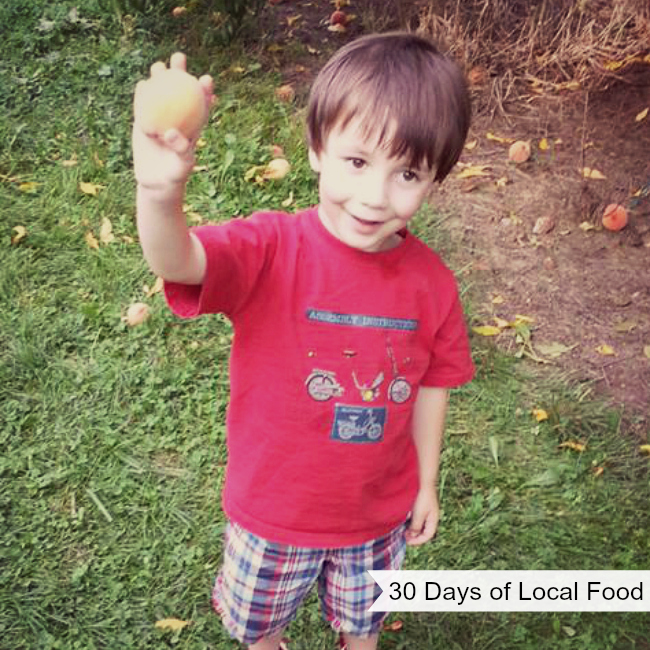
For fun, my family and I did an experiment for the month of August. We talk a lot about eating local food, and were already purchasing quite a bit from local sources — but could we buy only locally produced food for an entire month? We wanted to find out.
The Rules
We talked a bit about what was allowed and not allowed just a few days before our experiment began. Here is what we decided:
- My pantry was fair game. I didn’t want food to go bad that I had purchased previously, and I wanted the use of my oils and spices. However, we decided that if I ran out of something I would not purchase anything I could not get from a local source. I also was not allowed to stock up on anything in preparation for this, we thought that would keep us from being creative and would be cheating.
- While we wanted to get food primarily from nearby farms and the farmer’s market, anything we could get to and come home in a comfortable daytime drive would be acceptable.
- We wouldn’t let the kids starve. If it got to the point that they weren’t eating well, we’d make a trip to the store.
- We wouldn’t go over budget. For us, that’s $120 a week, max. Ideally, more like $100 for our family of four.
Did We Cheat?
The first week, we ran out of oats and sugar. Then, I forgot to put in our food co-op order so I couldn’t get oats or dried beans that we needed. I craved oatmeal, granola, oatmeal cookies, all the things we couldn’t have! We made it the rest of the month without it, but it did make breakfast in particular more difficult. We ate a lot of eggs as a result. I had honey and maple syrup and could get more easily, so we didn’t miss the sweetener too much as there were other options.
We did have to run to the store a few times, however. On one occasion we were having friends over for dinner and I was out of butter mid-week. I really needed butter for a pastry, coconut oil wouldn’t have tasted right and while I probably would have made our family just deal with the different flavor, it didn’t seem right to do that to guests. So we went to the store.
The other item we had to get from the store was milk. We have a cow share with a local farm and get a gallon of milk a week. At first when we ran out, we got a gallon at the health food store, but the options were quite old (as in it had sat on the shelf a long time) and had traveled farther than we wanted. Because of how expensive it was and we weren’t real happy with the quality, we supplemented with grocery store milk. Right now, we can’t afford to increase our cow share and my daughter had just stopped nursing and was transitioning to real milk so our intake was increasing as well. It was the best we could do without going over budget.
What We Learned
Because we relied on the farmer’s market, I didn’t really meal plan. We just made sure to get a good variety of meat, produce, and herbs each week and I’d “wing it” in the kitchen. We didn’t go over budget once, either! I brought cash; when it was gone, so was my shopping for the week.
Here are a few highlights from our month of eating primarily local food:
1. You really have to speak to each farmer to see how items were raised. I bought bacon and pork chops from one popular vendor in our area that advertised well treated pigs. When I pulled out the bacon later to fry, I saw the package said “nitrates added.” We still ate it since we didn’t want to waste it, but I was so disappointed! I learned my lesson, though. I do find it a little awkward asking farmers how things are raised, especially because so many are surprised by my questions. So I tried to do my homework ahead of time and read up on websites to find out where I was happy with the farming methods and to seek those places out. I followed up in person, but since the initial research was done, I was pretty much only talking to farmers with sustainable practices.
2. We ate less meat. With summer harvest on us and only so much room in the budget we ate more meals with veggies as the main course. We stretched our meat as far as we could, eating smaller portions of it and enjoying all the fruits and veggies of summertime. We bought a whole lot of zucchini in the abundance and enjoyed it with eggs, as a main dish in zucchini pie, and in chocolate cake. I became much more creative in the kitchen as well, really thinking spontaneously with what we had and creating new pairings. We ate like kings!
3. We found great sources of local food we didn’t know we had available. We found buffalo mozzarella and cultured butter. And even gooseberries — which I didn’t know we had in Northern Virginia!
4. When doing a full grocery shop at the farmer’s market it is really helpful to bring a cart or stroller to hold bags. (By the way, bring reusable bags with you to farmers’ markets! Not all farmers have bags there for you!) I went one week with the kids but without my husband and had a really hard time juggling a full week’s worth of food from one vendor to the next. I was really missing our big stroller with the bag clip! Also, if you need high demand items like eggs, get there when the market opens. We went two hours after opening one Saturday and all the eggs were sold out for the day.
5. My husband had been struggling mysteriously with heartburn for months. Changing and omitting different foods from his diet hadn’t helped. For the entire month of August, though, he had no heartburn at all. We don’t know what “fixed” it, but healthy, local food has countless benefits, apparently some unseen. 🙂
While I don’t think we could sustain “only local” long term because we do use coconut oil and a few other things that we can’t get in Virginia, we are continuing to eat much more local food than we were before. We would like to try this again in the winter months just to see if we can do it based on what would still be available locally.
What are your favorite local purchases? Have you or would you ever consider eating only locally produced food?
...without giving up the foods you love or spending all day in the kitchen!

2 free books:
Eat God's Way
Ditch the Standard American Diet, get healthier & happier, and save money on groceries...
We only recommend products and services we wholeheartedly endorse. This post may contain special links through which we earn a small commission if you make a purchase (though your price is the same).


I have a dairy that sells raw milk, cream, and cheese that is within an easy twenty mile drive. We are there more often than I would like to admit to stock up on items just for the two of us. We also have a neighbor who sells eggs (our girls aren’t laying yet), and another neighbor sells honey.
As much as I am a fan of the concept I honestly don’t know if I could do local only. I love to bake, so I use my spelt grains a lot. We also are big fans of coconut oil and I use it on a daily basis and not just in the kitchen. It would be hard but it would be a fun challenge. 🙂
Jenny, I totally agree it would be hard to sustain long term because of coconut oil and some grains that do come from farther away. It was a great exercise for us, though, and I really want to try to wean our dependence off some foods that are not truly sustainable for our location, or at least know enough substitutes that we could use in an emergency 😉
I love the summer for local eating! When the garden is producing and the farmer’s market full, local eating does seem possible. Long term though, I don’t think it would work for us here in the winter when the only place to shop is the grocery store. I love the idea though, and try to eat locally whenever we can!
I agree that winter is difficult, Andrea. I think putting things aside and dehydrating and preserving can help a lot, but I’m not sure how it would work to only use local through the winter. I want to try this again in the winter, it will be neat to see how it goes. 🙂
I’m floored by your budget being that you’re in Northern Virginia and eat well. We have to eat gluten free and do aim for healthy/natural/local/organic as much as possible as it’s easy $400 for 2 of us! We are pretty frugal and don’t do a milk share (would cost us over $60/month for 1 gallon a week). Can you actually attempt a breakdown of what you buy for an average month? That would be helpful for me to see where I can cut. I’m new to finding your blog.
I understand on the milk share, ours is only half that much. Our list reaaaallly varies by what I have stocked up and the season but a super general breakdown is sort of like this:
–$50 – all grains, dry beans, oats from our food co-op (whatever we’re low on – we have to spend $50 to place an order and we buy in bulk whatever we need)
–$30 cow share
–$30-60 other dairy we get from the farmer’s market or store – supplement milk, cultured butter, cheese, yogurt, etc
–$150 grass fed/pastured meats, usually from the farmer’s market, occasionally the best we can get at the store
$40ish on eggs a month from the farmer’s market..we go through about 2 dozen or a little more a week (we love eggs!)
–and the rest of the budget is seasonal veggies and fruits..we buy in bulk often from pick your own farms. the one consistant exception is we get bananas from the store..my kids love them in smoothies
You’ll notice that doesn’t add up exactly..because we don’t do the food co-op every month, just as we need items in the pantry getting low. It really varies so much, as we buy everything in bulk when we can. We buy oils and spices on sale from Trader Joe’s or online and we do a monthly or bimontly trip to an overstocked discount grocery store that has a lot of organic canned goods and baking items like tomato paste and chocolate chips. Because we get big quantities we don’t pay for those each month, in fact we buy coconut oil only twice a year or so as we get such large amounts. So one month we may spent $60 on oils, but nothing on meat because we bought a whole bunch in the bulk the last month, etc. We use our deep freezer A LOT.
We don’t really have a “trick” but we buy in bulk and really pay attention to prices..and we really limit “filler” foods..kids have apples or seasonal foods for snacks, not pretzels, etc. I hope that helps a little. The other constant grocery store item is coffee and tea..we just can’t find good sources for that locally, and we do enjoy our hot drinks. I hope that helps some..hard to outline when each month is so different.
This was my question too. I couldn’t believe you stuck within that budget for four of you! I try to keep our budget $120 or under also but it seems impossible! Question- the shares- like the cow share- do you pay those in one large chunk at the beginning of the season? I think what is a tragedy for many families, including our own, is that if you can’t afford upwards of hundreds of dollars up front to cover your share you are left having to buy week to week and thereby pay a great deal more just to provide your family with real food.
Jenny, I think it’s amazing how your experiment had the side effect of fixing your husband’s heartburn. It continues to surprise me how many benefits real, whole, fresh, healthy, local foods have or on the contrary how much damage packaged foods cause. Congrats on your successful results! On another note, I have to second Amanda’s comment on your budget. That is remarkable!
Thanks, Oge! 🙂 We were shocked and so excited as well by it fixing his heartburn! Healthy food has done so much for us..taken care of gall bladder issues I’ve had before, too 🙂
I would love to try this as well…we are trying to grow as much as we can to be more self sustainable and we have some friends who are doing the same so we are looking at going In together on some stuff…our friends with more land are going to raise some cattle, we have less land so all try for a few goats and my hubby took up hunting hoping top get his limit this year to stock our freezer. We would def have to change some things but j think itz great practice for kids for when times are tough…you can still enjoy food but it helps is remember that the nutrition factors are primary and our enjoyment secondary;) thanks for posting this